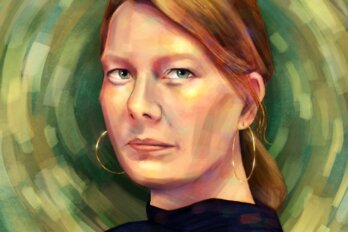Iam excited to tell Sarah Bernstein about a T-shirt that reads “PLOTLESS FICTION.” It’s from Type Books in Toronto, a merch offshoot of a beloved shelf of the same name in the bookstore. “I want that T-shirt,” she says.
Bernstein is the author of the Booker- and Giller-shortlisted Study for Obedience, where “little actually happens,” according to a positive review in the Guardian. A critic for the Scotsman lauded the prose but admitted to sighing, “Where’s the bloody plot?” But things do happen in Study for Obedience. The book is set in motion when the unnamed narrator moves to an unnamed country: “the country, it transpired, of our family’s ancestors, an obscure though reviled people who had been dogged across borders and put into pits.” She uproots her life at the behest of a demanding older brother, who had decided early on that “it would be my life’s work to reorient all my desires in the service of another, that was the most I should expect to achieve.” The brother abruptly leaves days after her arrival, and she lives in isolation. She can’t pick up the local language. And despite efforts to join in village life, the townsfolk are terrified of her. They shield their children from her glance and surreptitiously cross themselves in her presence. She is blamed for a potato blight, a local dog’s phantom pregnancy, and an outbreak of bovine madness. The book grapples with many below-the-surface themes: power and gender dynamics, exile, antisemitism, and survival. It’s a slim, atmospheric novel that’s both unnerving and darkly funny.
Originally from Montreal, Bernstein moved to Scotland in 2013 and is an English lecturer at the University of Strathclyde. She lives with her partner in a remote village in the Scottish Highlands. Her 2021 novel, The Coming Bad Days, is about a woman in self-imposed exile. I ask where she falls on the plotless fiction spectrum. “I wouldn’t know plot if I saw it, to be honest,” she says over a Zoom call. Bernstein is surprised by her new book’s nominations and modest about her accolades. But she’s firm about her work. “I object to the idea that there’s no story in this book.”
So-called plotless fiction isn’t exactly new. Many writers and critics, including Bernstein, cite modernist works such as Virginia Woolf’s Mrs. Dalloway as an early example of a book where action isn’t foregrounded and much of the story takes place inside characters’ heads. But lately, the sub-genre has become a topic of discussion, increasingly cropping up in pieces of literary criticism as well as online spaces such as Goodreads and BookTok and rattling the rules of how a story should unfold and even how we’re meant to read.
“No plot just vibes” books are often linked to female writers and passive characters. Examples include Sally Rooney’s novels which, though organized around the marriage plot, tend to feature submissive heroines—they aren’t forcing a plot along by actually doing things. In the very first line of Rooney’s Normal People, the main female character reacts to what the male lead does: “Marianne answers the door when Connell rings the bell.” And Ottessa Moshfegh’s My Year of Rest and Relaxation, a book in which the heroine drugs herself so she can sleep away a year, is often held up as a foundational text for the contemporary plotless fiction canon. In Study for Obedience, the narrator’s goal, from an early age, is one of submission and self-erasure: “I determined to eradicate my pride and my will.”
In a 2020 piece for the Los Angeles Times that interrogates critical reaction to both Moshfegh and Rooney, Lynn Steger Strong locates the trend of passive women in literature in an expansion of narrative form beyond the conventions of “Great Male Novels,” which often focus on agency. Strong says these novels explore the complexity underlying a lack of action as well as passivity’s “sometimes violent results.” No spoilers, but one of Study for Obedience’s epigraphs comes from the visual artist Paula Rego: “I can turn the tables and do what I want. I can make women stronger. I can make them obedient and murderous at the same time.”
If there’s another rebellion in this and other vibe-based books, it’s against the conventional story arc. Hovering above many readers’ heads is that English 101 line graph explaining how narratives unfold: rising action, climax, falling action, resolution. In a piece about “no plot just vibes” fiction in Elle, Caelan McMichael spoke to a number of authors who discussed playing with structure, shifting the focus to characters’ interior worlds and away from the “overarching events” that often guide more conventionally plotted stories. Happy Hour author Marlowe Granados referenced the standardized arc: “It was never my taste.”
Jane Alison, in her book Meander, Spiral, Explode: Design and Pattern in Narrative, critiqued the traditional plot. “Something that swells and tautens until climax, then collapses? Bit masculo-sexual, no?” she writes. “So many other patterns run through nature, tracing other deep motions in life. Why not draw on them too?”
I ask Bernstein about her academic bio, in which she says she’s interested in the idea of literary “difficulty.” She brings up Gertrude Stein, the avant-garde poet and novelist known for experimenting with form. Bernstein says when she teaches Stein’s Tender Buttons, the majority of students hate it at first. They’re used to reading quickly, trying to absorb plot and extract meaning, but some of them come around.
She says she enjoys books where the writer has thought a lot about the sound or shape of the sentences. That might be the key to understanding how to read Study for Obedience: following the voice, reflecting on what the narrator says and doesn’t say, and taking time with the story. In the novel, action feels less central than language and how the narrator interprets her new life and the reactions of the villagers to her presence. She recounts events and details her family history in an almost incantatory monologue that sometimes doubles back on itself. The rhythms of the prose can lull you along, and when you’re confronted with a jarring admission or image, such as a stillborn lamb, it feels particularly startling.
Getting into the cadence of the story, admittedly, didn’t happen right away for me. For a book about obedience, it ended up defying many of the rules I had absorbed about literature. The stories I’ve loved have often been deeply rooted in specific places and times. In Study for Obedience, the vagueness of the geography and aspects of the narrator’s identity forced me to reassess how namelessness can open up a story to a wealth of different interpretations.
“I’m really interested in the process of slowing down, coming back to [the pleasure of] reading. . . . It’s probably kind of rich of me to say because, according to the internet, my book is not pleasurable,” Bernstein says. “I took great pleasure in writing it.”






